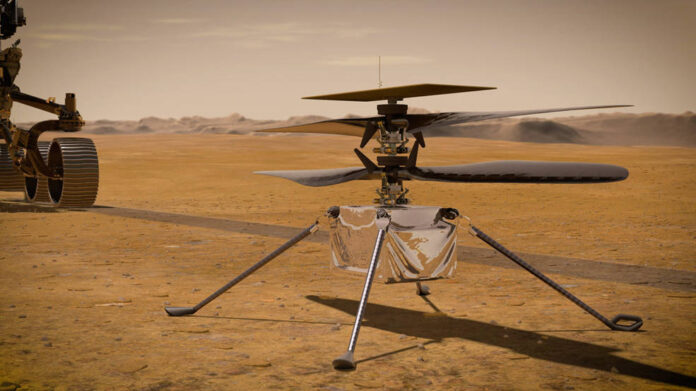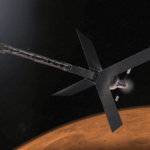This morning here in the Eastern time zone we were treated to the first pictures of the Ingenuity helicopter doing its own Wright Brothers’ imitation. Mind you the helicopter weighs considerably less than the Flyer, the box-kite-looking biplane that achieved first powered flight in 1903.
The Wright Flyer, weighing 274 kilograms (604 pounds), on its first flight, attained a speed of 16 kilometers (10 miles) per hour, was airborne for 12 seconds and traveled 260 meters (852 feet). Ingenuity weighing 1.8 kilograms (4 pounds) rose vertically, approximately 3 meters (10 feet), and hovered before descending to touch back down on the surface. Total flight time was 39.1 seconds.
The 49-centimeter (19.3-inch) tall helicopter bears little resemblance to helicopters we see here on Earth. A twin-rotorcraft it has to overcome a Martian environment which is far different from Earth’s. First, Mars’ gravity is one-third of that found here on Earth. Second, its atmosphere at ground level is 1% of the density of Earth’s. Third, it has to stay warm in an extremely cold environment so that all its parts work.
There is little air resistance in the Martian atmosphere to allow for flight. With so few air molecules with which to interact, the twin-rotor blades, each measuring 1.2 meters (4 feet) need to overcome this lack of air resistance by spinning at rates of speed well beyond helicopters here on Earth.
Just how fast?
As Ingenuity flies its twin blades spin at a rate of 2,400 revolutions per minute. Compare that to rotation speeds on small helicopters here on Earth at 400 to 500 per minute or on large ones like the Chinook that rotates at 225 per minute. And one other thing, Earth helicopters don’t have stacked rotors. They place a second rotor strategically on the airframe to counter Newton’s third law of motion which would cause the body of the helicopter to spin in the opposite direction to the rotor blade. That’s why the Ingenuity design stacks the rotors one atop the other and spins them in the opposite direction.
Having demonstrated this morning that an aircraft designed and built here on Earth can fly on Mars, the next few days should be exciting for Ingenuity’s creators, the Jet Propulsion Laboratory (JPL) team in Pasadena. A second flight likely will happen this week, and that may be followed by more over the next few weeks before the helicopter will be parked permanently.
This next test flight will demonstrate the ability of the helicopter to fly not just vertically but horizontally. Hovering in mid-air gives you very limited new capability. But moving in a horizontal direction makes Ingenuity a powerful new exploration tool.
What’s involved in horizontal flight?
Ingenuity will have to tilt its rotors on an angle that will alter its lift profile allowing it to fly horizontally. Operators at JPL will send instructions to the helicopter ahead of time. Its onboard artificial intelligence will translate them into a flight plan. The helicopter will then operate autonomously. If it doesn’t crash, it should be an exciting demonstration of the possibilities that lie ahead for powered flight on Mars.
Why fly on Mars?
When NASA first landed on Mars in 1976 with the two Vikings they were immobile. They could sample and image only what was within their reach. Since then there have been other landers and several rovers. Rovers turn our robots into explorers by putting wheels under them. The result today is that we have tons of data and images collected over tens of kilometers of the Martian surface at various sites.
But even wheeled robots have limits. Spirit got stuck in the sand and eventually died. And wheels don’t get you down a 90-degree cliff face. But a helicopter can. An airborne robot can explore the heights of Olympus Mons or descend into the Valle Marineris, Mars’ Grand Canyon, not just sending us spectacular images, but doing some amazing hard science as well.
And in the future, we can perfect this technology to allow us to fly through the atmosphere of Venus or descend through the clouds of Titan to study its Earth-like terrain.
NASA calls Ingenuity a demonstration project, one of many the agency has undertaken. Well, today we got a chance to see the future of planetary exploration and look forward to the next few weeks as Ingenuity is put through its paces.
















